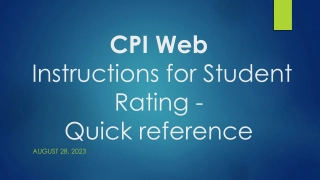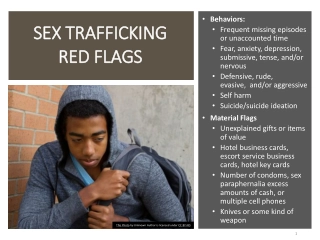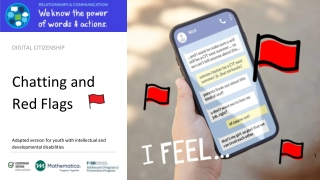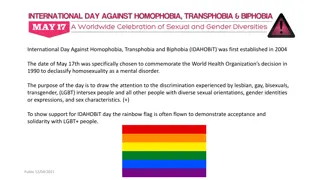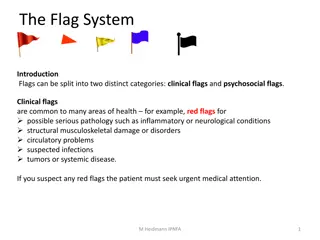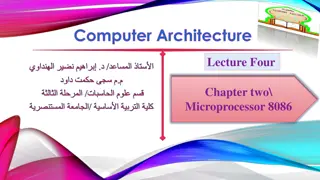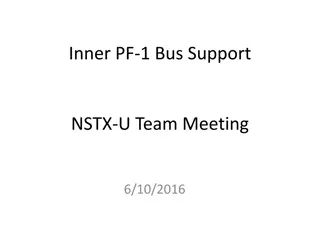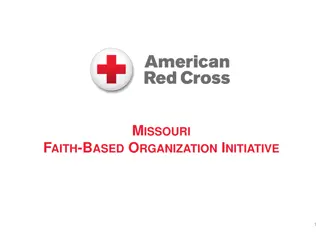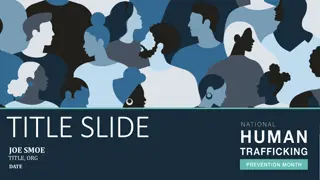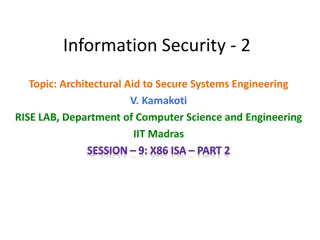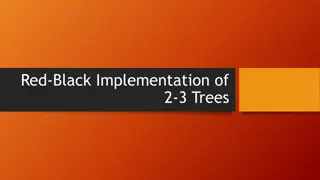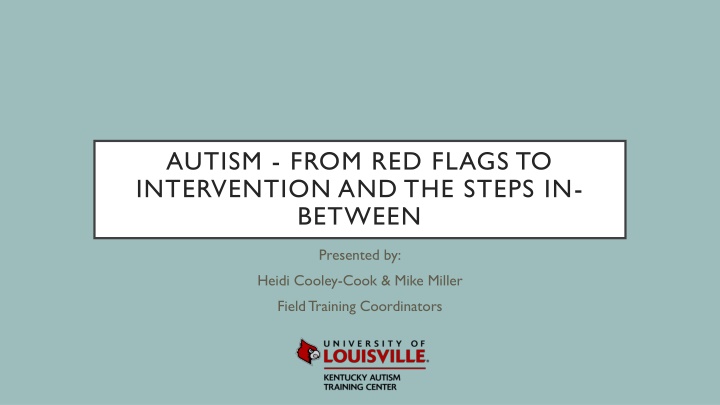
Autism: Red Flags, Interventions, and Steps in Between
Explore the world of autism from red flags to interventions, highlighting the prevalence, demographics, and early signs of this lifelong developmental disability. Learn about the spectrum disorder, common misconceptions, and the importance of early diagnosis and intervention for improved outcomes.
Download Presentation

Please find below an Image/Link to download the presentation.
The content on the website is provided AS IS for your information and personal use only. It may not be sold, licensed, or shared on other websites without obtaining consent from the author. If you encounter any issues during the download, it is possible that the publisher has removed the file from their server.
You are allowed to download the files provided on this website for personal or commercial use, subject to the condition that they are used lawfully. All files are the property of their respective owners.
The content on the website is provided AS IS for your information and personal use only. It may not be sold, licensed, or shared on other websites without obtaining consent from the author.
E N D
Presentation Transcript
AUTISM - FROM RED FLAGS TO INTERVENTION AND THE STEPS IN- BETWEEN Presented by: Heidi Cooley-Cook & Mike Miller Field Training Coordinators
WHAT IS AUTISM Autism is a lifelong developmental disability, resulting from a neurological disorder that affects the brain functioning.
PREVALENCE OF INDIVIDUALS WITH ASD 1 in 68 March 2014 CDC report
DEMOGRAPHICS Knows no racial, ethnic, or social boundaries Five times more prevalent in boys (1 in 42) than girls (1 in 189) Usually affects sensory and motor processing systems of the brain Varying degrees of severity in different individuals -Centers for Disease Control, 2014
AUTISM ISA SPECTRUM DISORDER Autism PDD-NOS Asperger's Syndrome Rett s Syndrome Childhood Disintegrative Disorder
Autism affects how an individual thinks, communicates, and interacts with others
AUTISM IS NOT A mental illness The result of bad parenting Unruly individuals who choose not to behave Always associated with mental impairment Always associated with behavioral challenges The same in every child
CHILDREN DO NOT OUTGROW AUTISM, BUT Studies do show that early diagnosis and intervention lead to significantly improved outcomes. (IDEA for Partnerships)
EARLY SIGNS The characteristic behaviors of autism may or may not be obvious in infancy (12 to 18 months) but usually become more apparent during early childhood (16 months to 6 years)
RED FLAGS What to look for? Communication/Language Skills Social Interaction Repetitive Behaviors & Restricted Interests
RED FLAGS Impairment in Communication: Lack of showing gestures Lack of coordination of nonverbal communication Unusual prosody (little variation in pitch, odd intonation, irregular rhythm, unusual voice quality) Delayed speech and language skills (First Signs Red Flags, 2010)
RED FLAGS Impairment in Social Interaction: Does not participate in or enjoy pretend play Poor joint attention Poor response to social bids Lack of appropriate eye gaze Lack of warm, joyful expressions Lack of sharing interest or enjoyment Lack of response to name (First Signs Red Flags, 2010)
RED FLAGS Repetitive Behaviors and Restricted Interests: Repetitive movements with objects Repetitive movements or posturing of body, arms, hands or fingers Likes parts of objects Has to follow certain routines Flaps hands, rocks body, or spins self in circles (First Signs Red Flags, 2010)
RED FLAGS FOR AUTISM Child does not babble or coo by 12 months Child does not gesture (point, wave, grab) by 12 months Child does not say single words by 16 months Child does not use 2 word phrases on his own by 24 months Child loses language or social skills after having acquired them
ADDITIONAL RESOURCES National Dissemination Center for Children with Disabilities http://nichcy.org/ First Signs www.firstsigns.org Centers for Disease Control Baby Steps: Learn the Signs. Act Early http://www.cdc.gov/ncbddd/actearly/index.html
EARLY IDENTIFICATION IS KEY If a parent is concerned about a child s development, it is important that the parent talk to the child s pediatrician. The pediatrician may be able to refer the child for further evaluation. If the pediatrician does not share the parent s concerns, the parent should consider seeking a second opinion from a professional who specializes in ASD.
SHARING CONCERNS Use sensitivity and choose words wisely Remain objective Highlight strengths as well as deficits Consider cultural sensitivities CDC Tips for talking with Parents http://www.cdc.gov/ncbddd/actearly/pdf/parents_pdfs/tipstalkingparents.pdf Autism Speaks Talking to Parents about Autism Kit http://www.autismspeaks.org/what-autism/learn-signs/talking-parents-about-autism-action-kit
FIRST STEPS If the child is under the age of 3, encourage the parent to contact First Steps 1-877-417-8377
IF THE CHILD IS OVER AGE 3 If the child is in preschool or elementary school, encourage the parents to talk to the child s teacher about any concerns. If the child is not in preschool, encourage the parents to contact the local school district and inquire about services available.
PATH: MEDICAL DIAGNOSIS There are specific parameters for the diagnosis of ASD with two levels of assessment: The first level is screening The second level, for those who fail the screening, can involve a multidisciplinary assessment by a variety of clinicians with experience in working with individuals with ASD
WHAT IS MULTIDISCIPLINARY? A team of professionals from various backgrounds which may include any of the following: Developmental pediatrician Child psychiatrist Clinical psychologist Occupational therapist Physical therapist Speech/language pathologist Social worker
DSM-IV DSM-5 Domains/Categories Three domains: Social Impairment Language/Communication Impairment Repetitive/restricted/stereotyped behaviors Two Categories: Social Communication Impairment Restricted interests/repetitive behaviors Diagnosis Requirements At least 6 out of 12 deficits in the three domain areas 3 deficits in social communication At least 2 symptoms in Restricted Repetitive Patterns of Behavior/Interests New symptom: Hyper- or hypo-reactivity to sensory input or unusual interests in sensory aspects of the environment
DSM-5 AUTISM SPECTRUM DISORDER A.Persistent deficits in social communication and social interaction across multiple contexts, not accounted for by general developmental delays, and manifest by all 3 of the following: Deficits in social-emotional reciprocity Deficits in nonverbal communicative behaviors used for social interaction Deficits in developing, maintaining, and understanding relationships B. Restricted, repetitive patterns of behavior, interests, or activities as manifested by at least 2 of the following: Stereotyped or repetitive motor movements, use of objects, or speech Insistence on sameness, inflexible adherence to routines, or ritualized patterns of verbal or nonverbal behavior Highly restricted, fixated interests that are abnormal in intensity or focus Hyper-or hypo-reactivity to sensory input or unusual interest in sensory aspects of the environment
Dimensional Ratings for DSM 5 ASD Fixated Interests and Repetitive Behaviors Social Communication Requires very substantial support Severe deficits in verbal and nonverbal. Very limited initiation of social interactions and minimal response to overtures. Inflexibility of behavior, extreme difficulty coping with change, RRBs that markedly interfere in all spheres. Great Distress Requires substantial support Marked deficits with limited initiations and reduced or atypical responses. Impairment apparent even with supports in place. Inflexible in behavior, difficulty coping with change, frequent RRBs and interfere in a variety of contexts. Some distress. Requires support With or without supports, noticeable impairments. Difficulty initiating social interactions and clear atypical responses. Maybe decrease social interest. Behavioral inflexibility causes significant interference in one or more contexts. Trouble switching. Problems organizing and planning.
RESOURCES AT THE UNIVERSITY OF LOUISVILLE Weisskopf Child Evaluation Center 502-588-0850 Bingham Clinic 502-588-0800 Neurology 502-588-8033 University of Louisville Autism Center 502-588-0736 fax: 502-588-0720
PATH: EDUCATIONAL ELIGIBILITY Submit written request for a referral for evaluation to determine eligibility for Special Education and/or Related Services RTI (Response to Intervention) Occurs after referral is made gives more information to guide types of assessments that will be needed Some students respond to RTI and may then not meet eligibility criteria for Special Education or Related Services These strategies (used in successful RTI) may be listed in a 504 Plan Contact Director of Special Education (DoSE) in the local school district School will conduct needed assessments based on type of eligibility School may choose to review outside evaluations 504 Plans and IEPs are governed by state regulations and federally thru IDEA
School-Age Eligibility for Special Education Services under Autism Disability Category
School-Age Eligibility for Special Education Services under Autism Disability Category
PATH: SUPPORT Local Support Groups Services and Supports Directory www.kyautism.org Ask an involved/active family in your community Local Recreational and Leisure Activities Encourage families to be active members of the community Support local businesses if they have questions about autism and/or supporting patrons with autism University of Kentucky Human Development Institute (HDI) Kentucky Disability Resource Manual https://www.hdi.uky.edu/products-resources
EVIDENCE BASED PRACTICES Antecedent based intervention Cognitive Behavioral intervention Differential reinforcement Discrete trial training Exercise Extinction Functional behavior assessment Functional communication training Modeling Naturalistic interventions Parent-implemented intervention Peer-mediated instruction/intervention Picture Exchange Communication System (PECS) Pivotal Response Training (PRT) Prompting Reinforcement Response interruption/redirection Scripting Self-management Social narratives Social skills training groups Structured play groups Speech generating devices/VOCA Structured Play Groups Task analysis Technology-Aided Instruction and Intervention Time delay Video modeling Visual supports
IN WHAT AREAS/TIME OF DAY CAN YOU USE THESE STRATEGIES? Most, if not all areas Throughout the course of the day BE CONSISTENT REMEMBER: If you have met one person with autism, You ve met one person with autism.
Make sure the behavior is. relevant (looks normal) reasonable (can be done by the individual) reinforced (can be observed by DSP) REINFORCEMENT IS KEY Remember: what works today may not work tomorrow! Likewise what didn t work yesterday, may work today!!!
FREQUENTLY RECOMMENDED INTERVENTIONS First Steps Developmental Pediatrician Community Living Supports Speech Therapy AAC devices Occupational Therapy Feeding Therapy Physical Therapy Counseling Psychiatry Neurology Behavior Supports BCBA Mental Health Professionals Respite Case Management
FUNDING MECHANISMS IN THE STATE OF KENTUCKY Medicaid (income based) Michelle P Waiver must have intellectual or developmental disability Home and Community Based Service Waiver (HCB) no IQ, age, or specific disability requirement Supports for Community Living Waiver (SCL) must have IQ lower than 70 Hart Supported Living Program Private insurance
COMMUNITY BASED VS SCHOOL BASED SERVICES Special Education and Related Services are determined by the school district and the ARC. Interventions and services must be relevant to the student s academic performance Student may receive additional outside services Recommended that if receiving services from multiple individuals/settings that a coordinated effort is made for on-going communication and collaboration Outside service providers are often not permitted inside the school to provide intervention/services The services that are provided inside the school are the districts responsibility and liability could be a factor Some school districts may contract with providers if they do not have someone in within the district that provides the service as identified in the IEP
QUESTIONS??? Heidi Cooley-Cook Family Field Training Coordinator 502-852-6401 heidi.cooleycook@louisville.edu Mike Miller Field Training Coordinator 502-852-7799 mrmill15@louisville.edu

